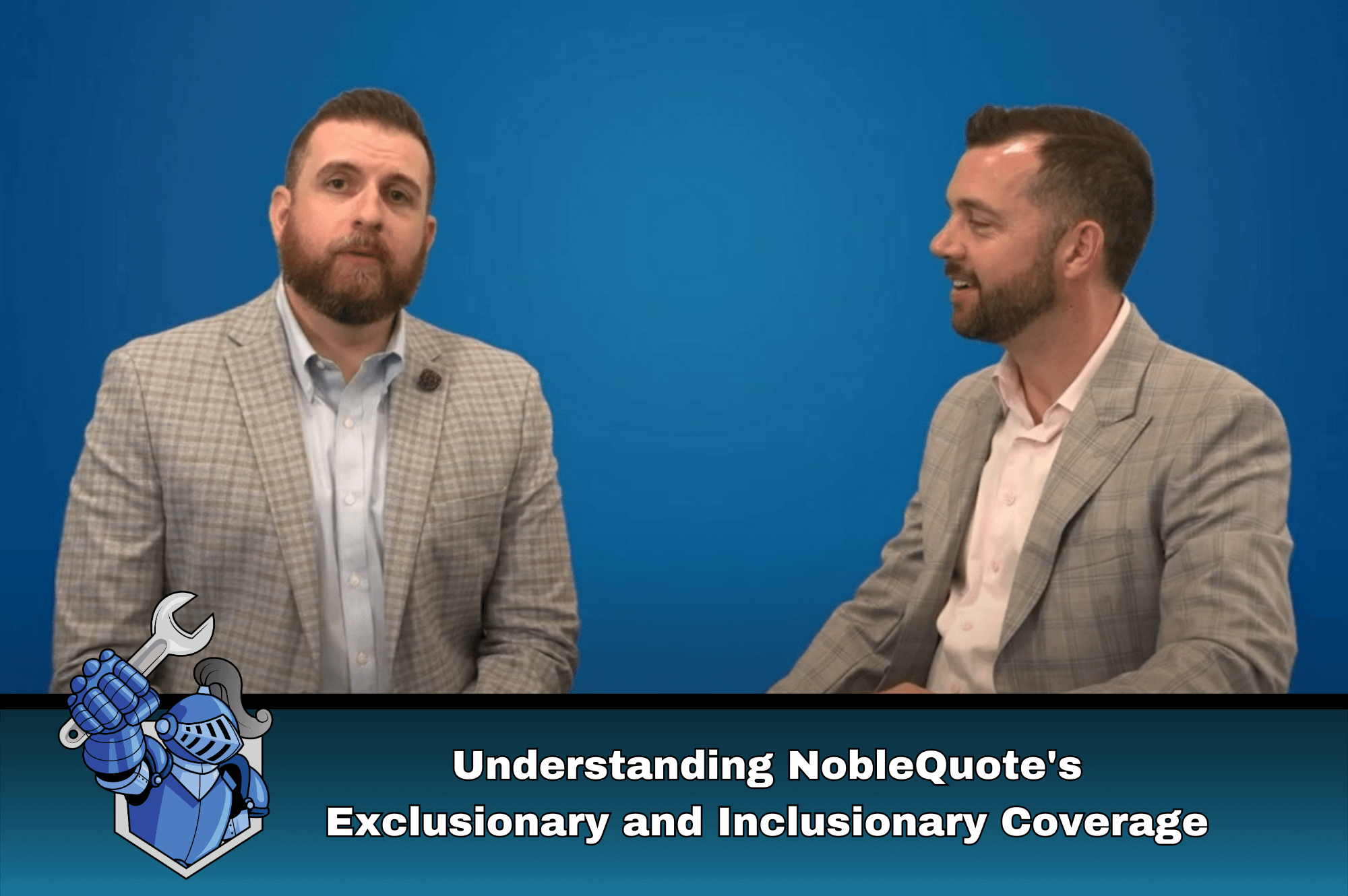When it comes to protecting your vehicle, choosing the right type of coverage is crucial. In this post, we will explore the differences between exclusionary and inclusionary vehicle breakdown protection plans, helping you make an informed decision. Whether you're a seasoned car owner or new to vehicle protection plans, understanding these options is essential for ensuring peace of mind on the road.
Watch Our Video:
Join Jason Coulter and Deric Kalamitsiotis from Pessada Holdings as they break down the differences between exclusionary and inclusionary coverage.
Exclusionary and Inclusionary Coverage Video Transcript
Jason 0:00:01
I'm Jason Coulter from NobleQuote, and I'm here with Deric Kalamitsiotis from Pessada Holdings. And today we're going to talk about one thing that we're hearing from our customers, and that's that they're getting all the things covered on their vehicle from a competitor. But one of the things that folks don't really realize is that there's two types of coverage. There's an exclusionary plan, and then there's an inclusionary plan. And it's exciting because Pessada holdings, they offer both.
Deric 0:26:12
You know, when we designed our programs, they were designed for new car franchise dealers, and a new car franchise dealer cannot sell a customer a plan that is an inclusionary, because what happens is when that car comes in, they're going to find a reason why not to cover it because of an exclusion. So what we offer is called exclusionary coverage. Exclusionary coverage is the most likely to mirror what the factory gave the customer when it was brand new. So what they're going to do is give you a small list of the items not covered. So an exclusionary plan is a true covers everything.
Jason 1:07:00
So you're saying there’s nothing better than that?
Deric 1:09:00
There is nothing better than that. And our exclusionary plans are better exclusionary plans than really any other administrator out there. Even on the new car side.
Jason 1:19:13
Impressive.
Deric 1:20:02
You don't really find coverage like we have, and we're offering that same type of coverage to Noble Consumer Protection, NobleQuote customers.
Jason 1:28:28
What about your inclusionary plans?
Deric 1:29:10
We do have inclusionary plans. And those are named components, which means they tell you what is covered. It's a list of specific items covered. If it's not listed, it's not covered. So what you might be hearing out there is competitors stating that that this is the best plan or you know, this is the best coverage, but is that the best coverage that's available to the customer, or is that the best coverage that that provider has offered to you as a consumer? So with our exclusionary plans, it's the most likely to mirror what the factory gives you as a one of the vehicles brand new.
Jason 2:13:10
So if you're looking to add the best coverage in the industry, click the link below or go to NobleQuote.com for your free quote today.
Key Features and Benefits of Exclusionary Coverage
Exclusionary coverage, often referred to as "bumper-to-bumper" coverage, is the most comprehensive type of vehicle protection plan available. This type of plan covers almost every component of your vehicle, except for those specifically listed as exclusions. Here are the key features and benefits:
- Comprehensive Protection: Exclusionary plans cover a wide range of parts and systems, including the engine, transmission, electrical components, and more. This minimizes out-of-pocket expenses for unexpected repairs.
- Peace of Mind: With exclusionary coverage, you can drive confidently, knowing that most major repairs will be taken care of, saving you from unexpected financial burdens.
- Resale Value: Vehicles with comprehensive protection plans are often more attractive to buyers, potentially increasing the resale value of your car.
How Inclusionary Coverage Works and Its Advantages
Inclusionary coverage, also known as "named component" coverage, lists the specific parts and systems that are covered by the plan. Anything not listed is not covered. Here are the advantages of inclusionary coverage:
- Focused Protection: Inclusionary plans are tailored to cover essential components that are most likely to fail, providing targeted protection without the cost of full coverage.
- Cost-Effective: These plans are generally less expensive than exclusionary plans, making them a viable option for those on a budget.
- Flexibility: Inclusionary plans can be customized to suit your needs, allowing you to choose the level of coverage that best fits your vehicle and driving habits.
Which Coverage Option Is Best for Your Vehicle?
Choosing between exclusionary and inclusionary coverage depends on several factors, including the age and condition of your vehicle, your budget, and your personal preferences. Here are some considerations to help you decide:
- Vehicle Age and Condition: Newer vehicles might benefit more from exclusionary coverage due to the higher value and complex systems. Older vehicles with higher mileage might find inclusionary coverage more cost-effective.
- Budget: If you have a limited budget, inclusionary coverage offers essential protection at a lower cost. However, if you can afford comprehensive protection, exclusionary coverage provides greater peace of mind.
- Driving Habits: If you rely heavily on your vehicle for daily commutes or long trips, comprehensive exclusionary coverage might be worth the investment. For occasional drivers, inclusionary coverage might suffice.
Real-World Examples and Insights from Industry Experts
To provide a better understanding of how these coverage options work in real life, let's look at some examples:
- Exclusionary Coverage Example: Imagine your car's transmission fails unexpectedly. With exclusionary coverage, the repair cost, which can be thousands of dollars, is covered, leaving you with minimal out-of-pocket expenses.
- Inclusionary Coverage Example: Suppose your vehicle's alternator fails. If you have inclusionary coverage and the alternator is listed as a covered component, the repair cost will be taken care of. However, if a non-listed part fails, you'll need to cover the repair cost yourself.
Expert Insights: Deric Kalamitsiotis from Pessada Holdings emphasizes the importance of understanding what is covered under each plan. "Exclusionary plans offer comprehensive protection but come at a higher cost. Inclusionary plans are budget-friendly but require careful consideration of the listed components."
Stay Informed with NobleQuote
For more detailed information and personalized assistance, visit NobleQuote's Learning Center. Our resources provide in-depth insights into vehicle protection plans, helping you choose the best coverage for your needs.
Frequently Asked Questions (FAQs)
1. What is exclusionary coverage?
Exclusionary coverage is a type of vehicle protection plan that covers almost all components of your vehicle, except for those specifically listed as exclusions.
2. What is inclusionary coverage?
Inclusionary coverage, or named component coverage, lists specific parts and systems that are covered by the plan. Anything not listed is excluded from coverage.
3. Which is better, exclusionary or inclusionary coverage?
The best coverage depends on your vehicle's age, condition, budget, and driving habits. Exclusionary coverage offers comprehensive protection, while inclusionary coverage is more cost-effective and provides targeted protection.
4. Are older vehicles eligible for exclusionary coverage?
Typically, exclusionary coverage is more common for newer vehicles. However, some providers may offer exclusionary plans for older vehicles with certain conditions.
5. How can I find out what components are covered under inclusionary coverage?
Review the coverage plan details provided by your service contract provider. The plan will list all covered components and systems.
6. Can I switch from inclusionary to exclusionary coverage later?
Switching coverage types may be possible, but it depends on the terms and conditions of your service contract. Contact your provider for specific details.
7. Where can I learn more about vehicle protection plans?
Visit NobleQuote's Learning Center for comprehensive information on vehicle protection plans and expert guidance.
By understanding the differences between exclusionary and inclusionary vehicle breakdown protection, you can make an informed decision that best suits your needs. Explore our resources and consult with our experts to ensure your vehicle remains protected on the road.
References:
Suggestions for you
Read MoreLet’s work together
Every week we showcase three charitable organizations that our donations are sent to. Our clients are able to choose which of these three will receive their gift when they add coverage to their vehicle...




